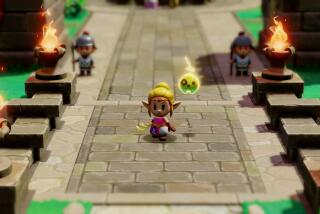Discover the joy of a game that transports you into the mythologies of ancient India
I played an hour of âRaji: An Ancient Epicâ before I stopped and restarted. While itâs not uncommon for players to reboot a game after learning its basic controls, that wasnât what made me want to begin again. âRaji: An Ancient Epicâ reminded me of a sensation I hadnât thought about much during the pandemic: the feeling of exploring and discovering a new place.
âRaji: An Ancient Epicâ isnât a replacement for a vacation, of course â no video game or virtual reality experience is yet that transportive â but it sparked a desire to analyze, to examine and to understand the in-game surroundings and its inspirations. A game that could be completed in a weekend stretched into a full week as I began writing down the names of deities such as Mahishasura and Kali for further research.
On the surface, âRaji: An Ancient Epicâ is an action adventure game.
Its tale of a young woman rescuing her brother from forces of the underworld can be told with many backdrops across numerous cultures. But âRaji: An Ancient Epic,â a labor of love that was often a struggle to get made by its small team, has a rather specific design intent. Beyond asking players to tackle its demon-like monsters with acrobatic fight moves, the game seeks to highlight a place â ancient India â and the culture it birthed.
Thus, as I advanced through âRaji: An Ancient Epicâ and dedicated myself to mastering the gameâs relatively robust combo-based fighting system, I discovered a decorative, lush world. The way âRajiâ mixes and matches game genres is slickly done â running, jumping and climbing through ruins requires precision and concentration. But for all of its sense play, the game also seems to possess an understanding of history. Its interactive text is built on mythologies that have gone largely unexplored in modern Western media, especially games, where an America obsession tends to dominate.
âRaji: An Ancient Epicâ made me feel like a traveler called to dig deeper, to learn more outside the game about the Hindu and Balinese legends, stories and settings that are interwoven into the project. One area of the game was directly inspired by the golden sandstone prevalent in the Indian city of Jaisalmer, home to the famed fortress whose tiered walls seem ripe for video game leaps. The intricate carvings of the Ajanta Caves served as inspiration, too, as our hero, Raji, traverses ruins with larger-than-life animal carvings.
âFrom the very beginning we wanted to do a game that represents Hindu culture. We didnât see any game that was made from India that had that,â says Shruti Ghosh, cofounder of the Pune, India-based Nodding Heads Games, whose founders had jobs at the Indian outposts of major game studios before going independent in 2017. âWe had not seen a game made with this mythology. So we just went for it.â
Meet Sandra Saad, who brings Ms. Marvel to the interactive screen in âMarvelâs Avengers.â
While the game uses religious iconography, seeking to re-create Indian temples and their patiently painted murals of Hindu legends, âRaji: An Ancient Epicâ itself is an original good-versus-evil story.
The gods and demons are shown in art throughout, and the game is narrated by the deities Durga and Vishnu. The small team uses the stories more to illustrate a lineage, to create the sensation that the player-led character is creating a new myth. Great pains, however, were taken to show reverence.
âSmudging the image of any god was a big no. Even small things, like in Hindu culture your feet cannot point toward a god,â says studio cofounder Avichal Singh.
âThis is a rule,â he continues. âYour feet shouldnât be pointing toward gods. Itâs disrespectful. If you have gods on your table, you canât put your feet up there. Weâve taken care of such small things. There was a moment where Raji was doing a wall-run over a particular statue, and we could not do that. The story of the game is the gods are watching you and blessing you, so thereâs no reason to have any kind of offense toward a god. It helped the game.â
Completing the game, which is currently available for the Nintendo Switch and coming to the PC, PlayStation 4 and Xbox One in October, became something of a mission for the team. For Ghosh, the more she studied the art of medieval India, the more she saw the game as a way to showcase traditions that are being lost â a point that was underlined when she and the studioâs third cofounder, Ian Maude, were in Bali and learned about passed-down mask-making traditions.
She crafted the gameâs hand-painted art style, including many of the murals that dot the digital rockwork. Occasionally, as Raji runs past them, they spring to life, becoming more animated as the narration tells of the bygone but venerable myths of the Hindu gods. Scaled down to the gameâs miniature art style, itâs a Pahari-inspired look that wouldnât be out of place in an ancient manuscript.
âIn India, all these art forms are slowly dying,â Ghosh says. âNobody wants to learn this anymore. Where are they going to be used? This is the reason I wanted to pay tribute to that style. Itâs so beautiful. Itâs so intriguing, and the amount of hard work, the exact patience you need to do this kind of art, is mind-blowing. But itâs going to be lost with time. So for people to see that there is something like this, and it can result in another art form, is something I wanted to bring to the game.â
Ghosh also orchestrated the gameâs interstitial scenes, which take their look from Balinese shadow puppetry. Here, the orange-yellow backdrops contrast the fragility of the paper-like cutouts with a sinister tone. And for those paying extra close attention, Singh says the fighting combos that players can piece together specifically recall martial arts moves that originated in India.
All this detail was helped in part by the time it took to make the game, even if the team was in a panic after a 2017 campaign on crowdfunding site Kickstarter failed. âWe used all our savings,â says Maude. While the team eventually linked with investor Super.com and also received in 2018 an Unreal Dev Grant from Epic Games, they were at one point asking their families for grocery money.
âWe were desperate for money,â says Maude. âShruti sold her apartment. But our families could see how important this project was to us. We were literally using all our funds to keep a roof over our heads. Us three werenât taking a salary.â
Of course, it helped, says the team, that when they went family seeking cash that they were working on a game that was encouraging them to discover a history that, as children, they sometimes rolled their eyes at.
âWeâve learned so much about things that we didnât know about our own gods,â Ghosh says. âI was calling my mother going, âIs this true? Is this actually true?â I come from a part of India where goddess Durga is worshipped the most, and my family has been worshipping goddess Kali since who knows when. For me, to read all this stuff has been eye-opening because I didnât care much when growing up. This has been formative for us too.â
More to Read
The biggest entertainment stories
Get our big stories about Hollywood, film, television, music, arts, culture and more right in your inbox as soon as they publish.
You may occasionally receive promotional content from the Los Angeles Times.












